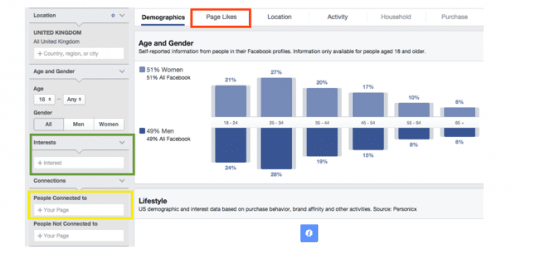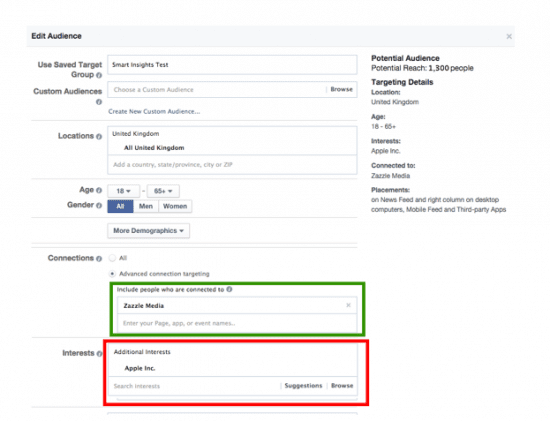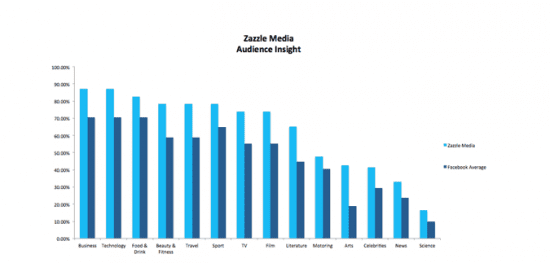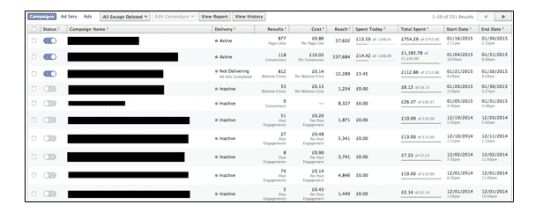An example of using Audience Insights and Ad Manager to reach your target audience
If you’re a digital marketer there is a high chance that over the last year you have noticed the increased relevance of content as the key factor to a successful content strategy. Algorithm changes at Google have become more reader focused meaning that good quality content is now priority number one.
The most difficult part of distributing content is pretty much down to the fact you are posting it online. With over 3 billion active Internet users in the world and counting meaning that the net is becoming an increasingly difficult place to get noticed. Social, and particularly Facebook, has always been a great way to publish your content to people who care about your brand.
No need to worry right? We’ve got a huge Facebook page with 500,000 likes so plenty of people in our audience will see this content. Well, unless you’ve been living on Mars for the past year, let me tell you that organic reach on Facebook has died.
Facebook is now a paid media channel. Socialbakers reported that a brand could expect to reach 6.15% of their total audience with brands that have over 500,000 likes reaching just 2.11% of their total audience.
Defining your Audience for your Paid Campaign
Before starting any paid campaign, which will obviously cost you money, you must fully understand your audience. You may have a good idea from previous campaigns but you need to be certain and should analyse your previous efforts by creating personas unique to you.
In addition, the information that social media can reveal about your audience can be invaluable in making the most out of your paid efforts. This allows you to understand your audience as people that makes it easier for them to have that important connection I mentioned earlier.
To get a good idea of what your audience will be interested in, I use Facebook’s Audience Insights tool within their Ads Manager.
To access this click 'Audience Insights' on the left hand side of the Ads Manager and then select 'Everyone on Facebook'. You will see the dashboard below. Then enter the brand that you want to find out more about their audience into the Interest section, highlighted green, or if you own the page in the People Connected To section, highlighted yellow. It will then process and give you tons of useful information about this audience from demographics and relationship status.

The real goldmine from this process is the information it reveals about audiences’ interests. The Page likes section highlighted red in the above photo will reveal the top categories and pages that an audience likes. This can really help to build an audience. Unfortunately this isn’t quantified however there is a way to do this.
To quantify this information it means delving into Facebook’s data and this can be done in the Ads Manager but I have better success using Power Editor. To gain access to the information you will need to set-up a test ad, edit the audience and add your page’s name into the 'Include people who are connected to' section. This will let you quantify the parameters that you put into the system.

By using the technique showed earlier I knew that people in Zazzle Media’s audience liked Apple Inc. so in this example I wanted to know how many people in Zazzle Media’s UK Facebook audience like Apple Inc.
To do this I put Zazzle Media into the 'include people who are connect to' (highlighted green) and noted that it gave me a total reach of 2,400. I then put Apple Inc. into the Interests section (highlighted red). This reduced the potential audience number to 1,300. This means that 54.16% of people in Zazzle Media’s audience like Apple Inc.
Repeat this process with a number of different interests and demographics to give you a full data set – similar to the one below – so you can truly understand your audience.

The Opportunities
Shareholders have become more important to Facebook than users these days – but, to be fair, they’re going to be as Gartner reported combined review for social networks topped $16bn in 2012 alone. However this focus on monetisation means there are now plenty of marketing opportunities.
It goes without saying that the most opportunities in social lay with Facebook due to the sheer size of their market share. However Twitter has started to find its feet with advertising and with Instagram, Pinterest, Snapchat and more refining and developing their systems it is more than likely that these opportunities will grow.
With Facebook having so many different types of paid avenues available to marketers. Whichever type you choose will depend entirely on the type of content you want to distribute.
Now we want to focus on content during this piece so the two types that will be of most value to you will be to either 'Clicks to Website' or 'Page Post Engagement'. The first will be for content such as interactive infographics, parallax and other types that require being hosted somewhere. The latter is more for types that can be hosted on Facebook – an image or video for example.
Test and go!
So now you should have a good idea where you want to distribute your content and the only thing left to do now is let it run and see what results you are getting. A common mistake is to just hit go on your promotion and just let the ads run. This is reality frustrating because you are spending your money and information revealed by your campaign could help you reduce the overall cost.
To make sure you are optimising your campaigns for the better you should test as many different ads as you can. Now there’s nothing more tedious than individually creating different ads for similar ads that might only differ slightly in targeting or imagery. So we use a system called Ad Espresso, which allows you to create a vast amount of different ads within one campaign in a short amount of time.
This gives you two wins because you will have a number of different ads to reveal vital information and data and it will also save you the time of doing each one individually.
It is imperative to check your ads and see which is the better performing. If one is becoming increasingly expensive, switch that one off and redistribute the budget to your efforts that are performing better.
Measuring success and analysing campaigns
In any Facebook campaign, measuring success relates completely to the objectives you set out at the start. For example, if your targets were to achieve social shares then a success metric for the campaign would be cost per social share.
It is imperative that, no matter how successful your campaign is, you need to analyse it to understand how it’s performing and when to refresh it. If you have a really successful campaign you will want to know why this has happened.
There are a number of factors that could contribute to this success. A good way of finding out this information is by comparing it with previous campaigns. Ask yourself what did I do differently? Is this more newsworthy? Did I use a different channel? Once you have covered these points you will start to understand why your campaign has gone so well.
For a very top-level view (below) you can just take the information given to you from the Facebook Ads Manager dashboard. It will automatically display the most useful information relating to your campaign. This can be useful for reporting information and results quickly to your bosses or clients!

To dig deeper into the information available regarding your campaigns simply click 'View Report'. Don’t panic at the lack of visuals but this screen will just throw a lot of data at you.
To get a bespoke report so you get the data you want to see you can tailor it by editing the which columns you see using the 'Edit Columns' buttons. This is especially valuable for marketers who are looking to keep their costs down as you can directly compare actions and cost per actions, for example. Then you’ll be able to see if your ads are only driving clicks, or likes, or comments. By refining these you will be able to see if it’s giving you the results and value that you want.
So Facebook is still here..
We all know the Internet is crowded and we can no longer rely on Facebook to publish content to a lot of people for free. But those people are still there and do want to consume your content so now you should understand Facebook content distribution, how to successfully launch, manage and fully understand the success of a campaign to still take advantage of Zuckerburg’s giant.

Thank you to Kyle Kirkland for sharing his thoughts and opinions in this blog post. Kyle is a social media consultant at
Zazzle Media, a UK-based digital marketing agency with a reputation as one of the leading lights in the world of digital content creation and distribution. You can connect with Kyle on
LinkedIn.







 Thank you to Kyle Kirkland for sharing his thoughts and opinions in this blog post. Kyle is a social media consultant at
Thank you to Kyle Kirkland for sharing his thoughts and opinions in this blog post. Kyle is a social media consultant at 


